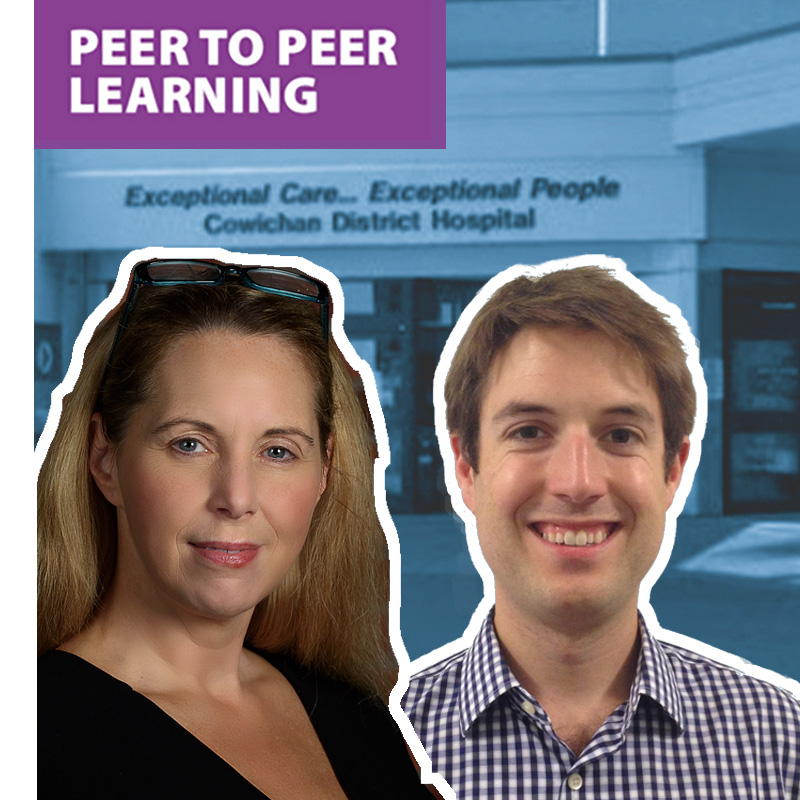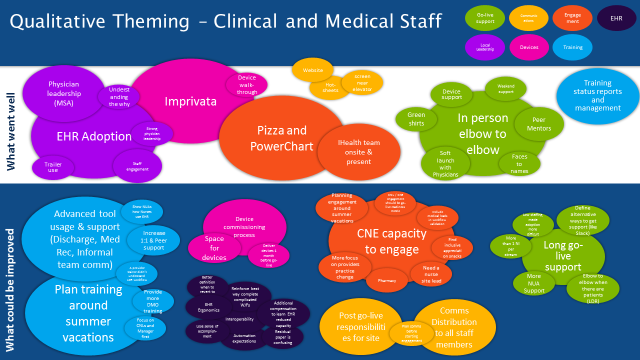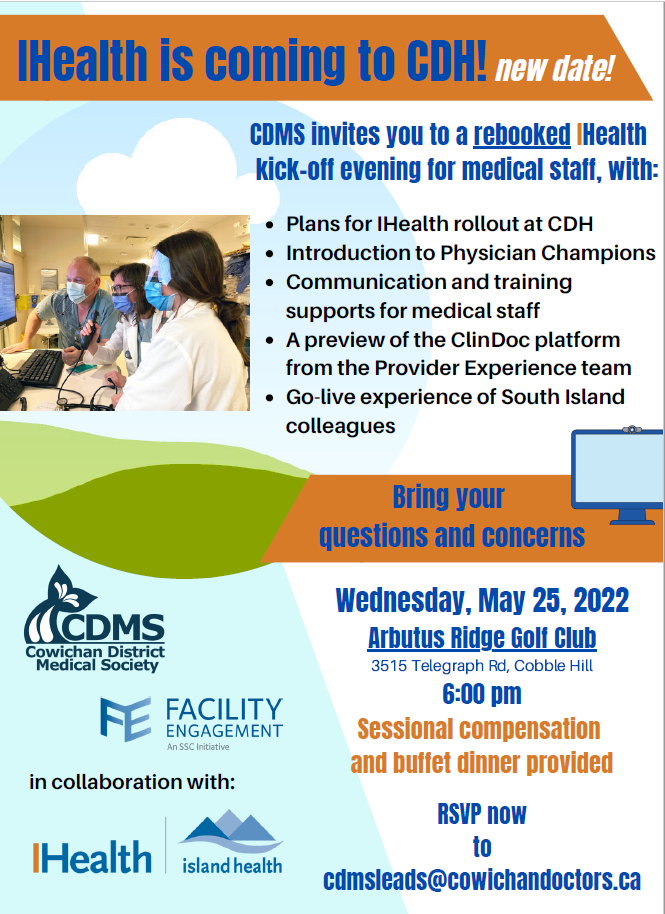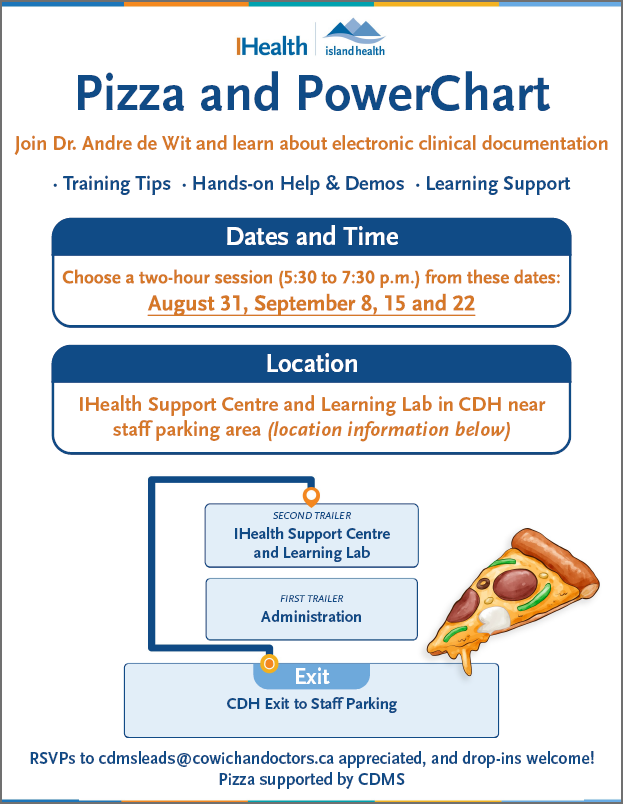
Across BC, health authorities and providers are introducing electronic patient health records (EHRs) to their hospitals and communities.
With the complexity of patient care across specialties and individual sites, and challenges of technology, successful implementation relies heavily on strong communication and connections between teams.
At Cowichan District Hospital, extensive efforts to build relationships, communication and trust as a foundation for change led to a smooth rollout of the first phase of IHealth, Island Health’s Cerner-based EHR.
Building trust and communication for success
In the spring of 2022, Cowichan District Hospital (CDH) began to implement Clinical Documentation – the first of two major components of IHealth.
Recognizing the need for this change but also the challenges in a system already under stress, Drs Tracey Stephenson and Ryan Gallagher stepped forward to represent the interests of patients and medical staff in the project, while building connections with the IHealth team.
Dr Stephenson is an emergency room physician and co-president of the Cowichan District Medical Society (CDMS).
Her role was to represent the voice and concerns of medical staff in IHealth discussions and rollout planning – including medical staff not in a leadership position, smaller groups, and those who may have felt marginalized for a variety of reasons.
Dr Gallagher is a family physician who also provides maternity care at the hospital.
He straddled a dual role in implementation, to both represent the voice of local CDH medical staff in the rollout, and to provide physician leadership on the regional IHealth team.
With strong relationships already established in the medical community, Drs Gallagher and Stephenson began the work to get medical staff on board by encouraging collaboration among the groups involved.
“We were looking to create a collegial environment which would allow the transition to benefit from the knowledge of each group,” said Dr Gallagher.
“Local staff provided expertise on how we work at CDH, while the IHealth team provided expertise on what the EHR can do.”
“By working together, we were able to understand the best solutions for our site in the context of the whole health authority.”
Dr Stephenson noted, “We wanted to build relationships and lines of communication with the excellent people who work within the Island Health rollout team, and the CDH medical staff who we knew wanted to do their best for patients and wanted this technology.”
“We wanted them to really feel supported in a collaborative learning experience, with an opportunity for growth on all sides.”
CDMS Facility Engagement funding supported a number of relationship-building experiences for medical staff to learn from the IHealth team, to get to know each other, and to ask questions.
Activities started with larger social-style teaching events, and then moved to smaller connecting opportunities such as drop-in sessions with food, zoom sessions, and notably, popular “Pizza and Power Charts” sessions.
Having flexible options increased opportunities for the high number of community family doctors who see patients at the hospital to learn alongside inpatient teams.
CDMS Facility Engagement funding additionally supported specialties such as Surgery and Emergency to connect as a group and/or collaborate with other sites that had already implemented Cerner.
Through those connections, individuals got to know and trust each other. Medical staff felt well-supported through the implementation process and knew who to ask for help with issues or questions.
“Everybody really dug in, learned, and was interested, because there was that collaborative environment,” said Dr Gallagher. “There was the understanding that when you have a problem, people are going to listen. You don't get that if you don't trust the person across from you.”
Participants felt comfortable to have open conversations about how to fix issues that arose.
Frank conversations with the health authority, IHEALTH team, and CDMS were welcomed and easy to have, and people felt safe to share their concerns and experiences.
“Seeing the failures become conversations and further engagement, is maybe the biggest win,” noted Dr Stephenson. “It is the exceptional medical staff, nursing, and allied staff at CDH who really did all the work.
It was their resiliency and commitment to patient care that made this work.”
Medical staff also saw their efforts translate into bigger picture benefits.
“One of the really big positives of working together was turning this opportunity into something that wasn’t just a change, but actually a chance to fundamentally change, for the better, the way we deliver care,” noted Dr Gallagher.
“Our clinicians started asking questions like, ‘Okay, I get how to document. Now how do I optimize what I'm doing so it's better for patient care?’ I was really excited to see that."
Success Factors
- Having a dedicated physician leader to liaise between local medical staff and the regional IHealth team
- Involving MSA/Cowichan District Medical Society (CDMS) leadership from the beginning to represent for all medical staff but particularly those not represented within the health authority leadership structure, from smaller groups, or those feeling marginalized for a variety of reasons.
- Progressively building relationships, trust, and authentic collaboration
- Creating a range of opportunities for local medical staff to connect and learn, with strong IHEALTH participation and presence.
- Establishing transparent and safe two-way communication, in an environment of respect
- Having the support of enthusiastic physicians going above and beyond to get the most out of the EHR, and bigger wins
- CDMS Facility Engagement funding
Flexible learning sessions for medical staff, physician leads, IHEALTH Team
- Zoom sessions
- Social-style events
- Dinner and a chat
- Drop-in sessions with food
- Pizza and Power Charts
Lessons to move forward
- Support for greater engagement of nursing staff could be improved
- Plan training around summer vacations

“We wanted to build relationships and lines of communication with the excellent people who work within the Island Health rollout team, and the CDH medical staff who we knew wanted to do their best for patients and wanted this technology.
We wanted them to really feel supported in a collaborative learning experience, with an opportunity for growth on all sides.”
– Dr Tracey Stephenson (left),Co-President, Cowichan District Medical Society
“Everybody really dug in, learned, and was interested, because there was that collaborative environment.There was the understanding that when you have a problem, people are going to listen.
“One of the really big positives of working together was turning this opportunity into something that wasn’t just a change, but actually a chance to fundamentally change, for the better, the way we deliver care." –Dr Ryan Gallagher (right), Family Physician, Physician Leader, IHealth




